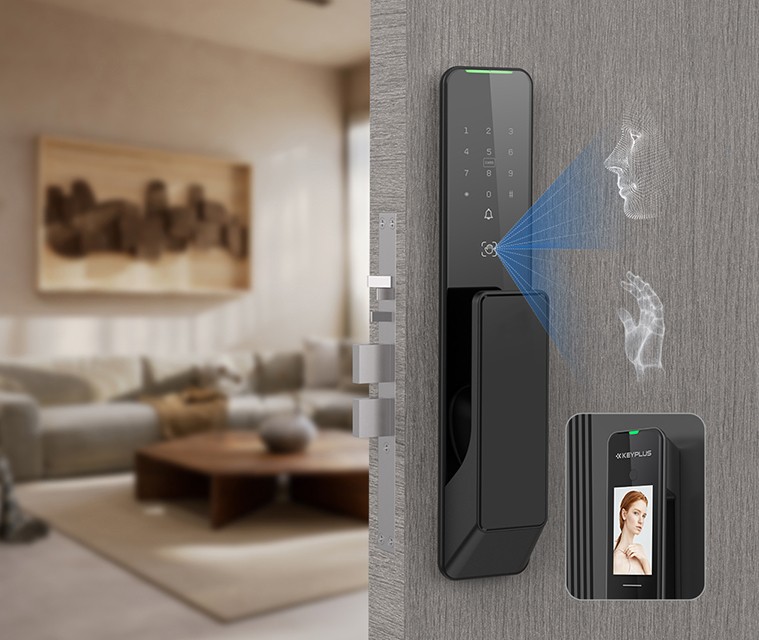How Does Face Unlock Work? A Complete Guide to Facial Recognition Technology
Facial recognition has become a common feature in smartphones, smart locks, and security systems. But how does face unlock actually work? Is it secure? And what are its limitations?
This guide explains the science behind facial recognition technology in simple terms, helping you understand how your face can replace keys and passwords.
1. The Basics: What Is Face Unlock?
Face unlock is a biometric authentication method that uses your facial features to verify your identity. Instead of typing a password or using a fingerprint, you simply look at a camera or sensor, and the system grants or denies access.
Where Is Face Unlock Used?
- Smartphones & tablets (for unlocking devices).
- Smart home locks (keyless door entry).
- Airport security & banking (identity verification).
- Workplace attendance systems (replacing ID cards).
2. How Does Face Unlock Technology Work?
Facial recognition systems follow a three-step process:
Step 1: Face Detection
- A camera or infrared (IR) sensor detects a face in its field of view.
- The system identifies key facial landmarks (eyes, nose, mouth).
Step 2: Feature Mapping & Analysis
The system analyzes unique facial characteristics, such as:
Distance between eyes
Nose shape & width
Jawline & cheekbone structure
Skin texture & unique marks (scars, freckles)
Advanced systems use 3D depth mapping (measuring contours) instead of just 2D images for better accuracy.
Step 3: Matching & Decision
- The scanned face is compared to stored biometric data.
- If there’s a match, the device unlocks.
- If not, access is denied.
3. Types of Facial Recognition Technologies
Not all face unlock systems work the same way. Here are the most common types:
A. 2D Facial Recognition (Basic Camera-Based)
- Uses a standard camera (like a selfie camera).
- Pros: Low cost, works in good lighting.
- Cons: Easier to fool with photos; struggles in low light.
B. 3D Depth Sensing (Infrared/Structured Light)
- Projects thousands of invisible dots to create a 3D face map.
- Pros: Highly secure (hard to trick with photos/masks).
- Cons: More expensive; requires specialized hardware.
C. Infrared (IR) Facial Recognition
- Uses IR sensors to detect facial heat patterns.
- Pros: Works in complete darkness.
- Cons: May struggle with extreme temperature changes.
D. AI-Powered Facial Recognition
- Uses machine learning to improve accuracy over time.
- Pros: Adapts to aging, glasses, or facial hair.
- Cons: Requires more processing power.
4. Is Face Unlock Secure? Key Risks & Protections
Potential Security Risks
- Photo/Spoof Attacks – Some systems can be fooled by a high-quality photo or video.
- Twins or Lookalikes – Similar faces may trigger false unlocks.
- Privacy Concerns – Stored facial data could be hacked if not encrypted.
- Lighting & Angle Issues – Poor conditions may cause recognition failures.
How Modern Systems Prevent Hacking
Liveness Detection – Checks for blinking or slight movements to ensure it’s a real face.
Infrared/3D Scanning – Makes photo attacks nearly impossible.
Local Data Storage – Some devices store face data only on the device (not in the cloud).
5. Face Unlock vs. Other Biometric Methods
| Feature | Face Unlock | Fingerprint Scan | Iris Scan |
|---|---|---|---|
| Speed | Fast (~1 sec) | Very fast (~0.5 sec) | Fast (~1 sec) |
| Security | High (with 3D/IR) | Very High | Extremely High |
| Convenience | Hands-free | Requires touch | Requires precise alignment |
| Failure Rate | Moderate (lighting/angle issues) | Low (unless wet/dirty) | Very Low |
Best Use Cases:
- Face unlock: Best for quick, touchless access (phones, smart locks).
- Fingerprint: Best for high-security + speed (banking, offices).
- Iris scan: Best for maximum security (government, military).
6. Limitations of Face Unlock Technology
Despite its benefits, face unlock isn’t perfect:
- Doesn’t work well with masks, heavy makeup, or sudden appearance changes.
- Some systems struggle in bright sunlight or complete darkness.
- Not 100% foolproof (though 3D/IR models are close).
Pro Tip: For best security, use multi-factor authentication (face + PIN or fingerprint).
7. The Future of Face Unlock
Advancements in AI and sensor technology will likely improve:
Faster recognition (under 0.5 seconds).
Better anti-spoofing (detecting deepfakes or advanced masks).
More affordable (making 3D face unlock standard in budget devices).
Final Verdict: Should You Use Face Unlock?
Good For:
Convenience (no need to touch anything).
Modern security (when using 3D/IR systems).
Smart home & phone access (quick and seamless).
Not Ideal For:
High-security needs (use fingerprint/iris + PIN instead).
Extreme environments (bright sun, dusty/dirty conditions).
Conclusion: A Powerful (But Not Perfect) Technology
Face unlock is a fast, convenient, and secure way to authenticate—when implemented correctly. While no system is flawless, 3D and infrared-based facial recognition offers strong protection against most hacking attempts.
Would you trust face unlock for your phone or front door? Share your thoughts!
Post time: Jun-16-2025


